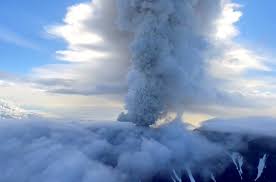In a rare and chilling geological event, Russia’s Krasheninnikov volcano erupted for the first time in 450 years, just days after a magnitude 8.8 earthquake struck the Kamchatka Peninsula — one of the most powerful quakes recorded in recent history.
The eruption sent a towering ash plume 6,000 meters (19,700 feet) into the sky and triggered an orange-level aviation alert, warning of possible disruptions to flight routes in the region.
United Airlines Flight to Munich Declares ‘Mayday’ After Engine Failure Midair
First Recorded Eruption Since 1550
The Krasheninnikov volcano, dormant since 1550, had shown no recent signs of activity until now. According to the Smithsonian Institution’s Global Volcanism Programme, this is the first recorded eruption of the volcano, and it follows what many experts believe may have been triggered by seismic shifts caused by the megathrust earthquake earlier this week.
“The plume is spreading eastward from the volcano toward the Pacific Ocean. There are no populated areas along its path, and no ashfall has been recorded in inhabited localities,”
— Kamchatka’s Ministry of Emergency Situations (via Telegram)
Watch the Eruption
Aerial footage shared on X (formerly Twitter) shows terrifying visuals of the ash cloud billowing into the sky as the volcano violently reawakens.
Orange Aviation Alert Issued
The orange aviation code, assigned by authorities, signals that the volcano is showing increased unrest with a strong potential for additional eruptions. While no nearby towns are currently threatened, flight paths over the Pacific may be impacted.
This marks the second major volcanic event in the region within a week. On Wednesday, Klyuchevskoy volcano—the tallest active volcano in Europe and Asia—also erupted, continuing its frequent activity with another explosive event.
Linked to Earthquake?
Geologists say both eruptions could be linked to the 8.8 magnitude earthquake that struck near Petropavlovsk-Kamchatsky just days earlier. That quake led to tsunami warnings from Japan to Hawaii and Ecuador, and severe damage in Russia’s Far East, including the flooding of Severo-Kurilsk port and a fishing plant.
“The Kamchatka seismic zone is one of the most active subduction zones around the Pacific Ring of Fire,”
— Roger Musson, British Geological Survey
With the Pacific Plate shifting west at 80 mm per year, experts caution that more aftershocks and volcanic activity may follow.
Final Thoughts
The rare eruption of the Krasheninnikov volcano, coupled with back-to-back seismic disasters, is a stark reminder of the volatile nature of the Pacific Ring of Fire. While no casualties have been reported so far, scientists warn the region remains on high alert.


1 thought on “Dormant Russian Volcano Erupts After 450 Years, Days After Massive Earthquake — Watch Scary Footage”